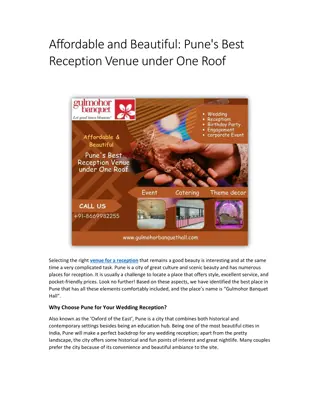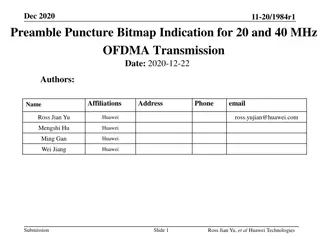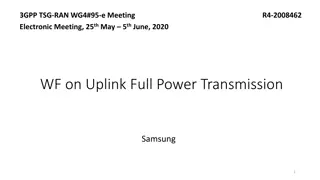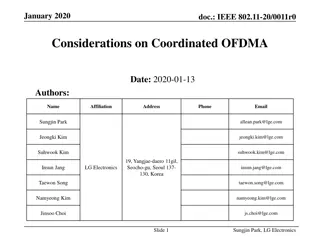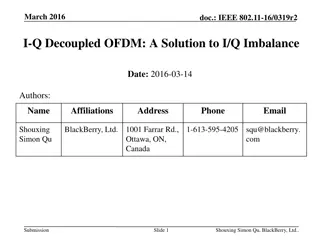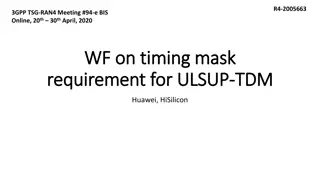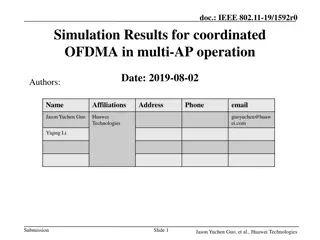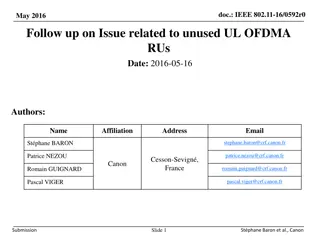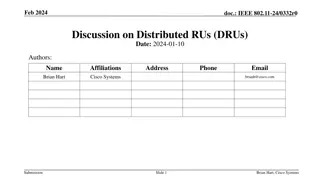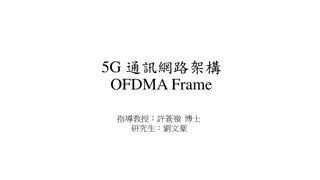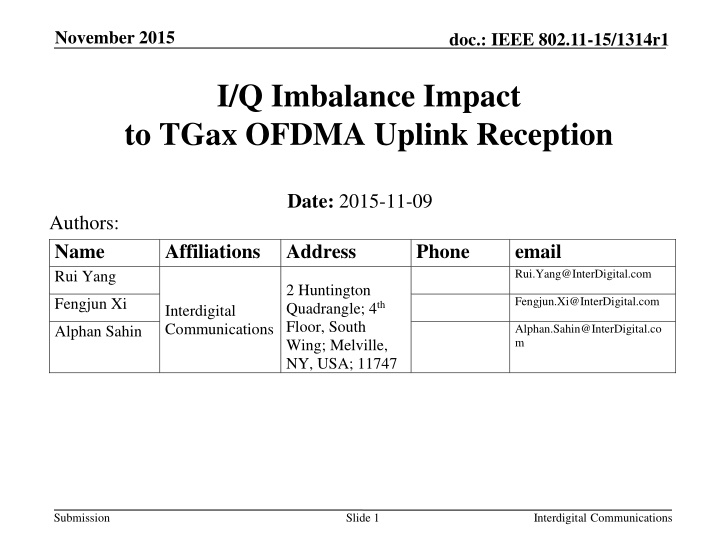
I/Q Imbalance Impact on TGax OFDMA Uplink Reception
Explore the effects of in-phase (I) and quadrature (Q) imbalance in RF devices on TGax OFDMA uplink performance through simulation. The study delves into the interference caused by I/Q mismatch and its implications on link quality. Detailed analysis of simulation results, assumptions, and conclusions are presented.
Download Presentation

Please find below an Image/Link to download the presentation.
The content on the website is provided AS IS for your information and personal use only. It may not be sold, licensed, or shared on other websites without obtaining consent from the author. If you encounter any issues during the download, it is possible that the publisher has removed the file from their server.
You are allowed to download the files provided on this website for personal or commercial use, subject to the condition that they are used lawfully. All files are the property of their respective owners.
The content on the website is provided AS IS for your information and personal use only. It may not be sold, licensed, or shared on other websites without obtaining consent from the author.
E N D
Presentation Transcript
November 2015 doc.: IEEE 802.11-15/1314r1 I/Q Imbalance Impact to TGax OFDMA Uplink Reception Date: 2015-11-09 Authors: Name Rui Yang Affiliations Address 2 Huntington Quadrangle; 4th Floor, South Wing; Melville, NY, USA; 11747 Phone email Rui.Yang@InterDigital.com Fengjun.Xi@InterDigital.com Fengjun Xi Interdigital Communications Alphan.Sahin@InterDigital.co m Alphan Sahin Submission Slide 1 Interdigital Communications
November 2015 doc.: IEEE 802.11-15/1314r1 Outline Abstract Background Simulation assumptions and configurations Simulation results Observations and Conclusions Submission Slide 2 Interdigital Communications
November 2015 doc.: IEEE 802.11-15/1314r1 Abstract In-phase (I) and Quadrature (Q) imbalance is a common RF impairment in wireless devices. We demonstrate, via simulation, the impact of the image interference due to I/Q imbalance to the link performance in TGax OFDMA uplink. Submission Slide 3 Interdigital Communications
November 2015 doc.: IEEE 802.11-15/1314r1 Background In OFDMA systems, transmitting a signal over a resource unit (RU) allocated on one side of the DC tone will create interference on the RU at the image side of the DC tone due to I/Q imbalances at Tx and/or Rx RF [1] The impact of interference depends on the level of the I/Q mismatch and relative power of the signals on the two image RUs at the receiver. RF I/Q Amplitude Imbalance: 1dB, Phase Imbalance: 5deg 10 Without Impairment With Impairment 5 Desired Signal 0 Image -5 Sideband Suppression (dBc) -10 Interference PSD -15 -20 -25 -30 -35 -40 -10 -8 -6 -4 -2 0 2 4 6 8 10 MHz Submission Slide 4 Interdigital Communications
November 2015 doc.: IEEE 802.11-15/1314r1 Simulation Assumptions I/Q imbalance model [1] : Consider Phase and Amplitude mismatch only ??= ??,?+ ???,?= 100.5?? 20 ?? + ? 10 0.5?? 20 ?? 2+0.5??? 180 ??,?+ e?? ??&?= ? ?0.5??? 180??,? I/Q imbalance (IQI) Parameters[2]: -30dBc: ??= 0.5?? and ??= 1 ??? -40dBc ??= 0.1875?? and ??= 0.3 ??? Submission Slide 5 Interdigital Communications
November 2015 doc.: IEEE 802.11-15/1314r1 Simulation Assumptions (cont d) TGax OFDMA UL Channel bandwidth: 20 MHz RU definition: 9 RUs with numerology defined in [3] RU allocation: RU2 STA2, RU8 The same transmit power from two STAs dP (dB): Received power difference at AP (0 25dB) For SS1 and SS4, the power difference (in dB) between the near and far STAs from AP could be more than 20dB (see the Received Power Analysis in Appendix). STA1 Received power difference at AP STA1 STA2 dP RU 8 RU 9 RU 1 RU 2 RU 3 RU 4 R U 5 R U 5 RU 6 RU 7 AP STA2 STA1 Submission Slide 6 Interdigital Communications
November 2015 doc.: IEEE 802.11-15/1314r1 Simulation Configurations Channel: AWGN, B-NLOS, D-NLOS Modulation: MCS2/4/6/8 (QPSK/16QAM/64QAM/256QAM) Encoder: BCC Packet length per RU: 100Byte/Packet Simulation length: 10,000 packets Rx I/Q imbalance compensation: Disable Use the same imbalance parameters as the transmitter, Enable No I/Q imbalance at receiver (AP). Ideal channel and noise power estimations Performance metric: PER of the signal from STA2 Submission Slide 7 Interdigital Communications
November 2015 doc.: IEEE 802.11-15/1314r1 Simulation Results (IQI = -30dBc vs. -40dBc, 64QAM, AWGN) AWGN, 64QAM(MCS6), IQI=-30dBc AWGN, 64QAM(MCS6), IQI=-40dBc 0 0 10 10 -1 -1 10 10 noIQ dP=0dB dP=5dB dP=10dB dP=15dB dP=20dB dP=0dB,Rx0 dP=5dB,Rx0 dP=10dB,Rx0 dP=15dB,Rx0 dP=20dB,Rx0 noIQ dP=0dB dP=5dB dP=10dB dP=15dB dP=20dB dP=0dB,Rx0 dP=5dB,Rx0 dP=10dB,Rx0 dP=15dB,Rx0 dP=20dB,Rx0 PER PER -2 -2 10 10 -3 -3 10 10 15 16 17 18 19 20 21 15 16 17 18 19 20 21 SNR(dB) SNR(dB) Legend: dP = xdB : The same I/Q imbalance applied to Tx and Rx sides; dP = xdB, Rx0 : I/Q imbalance applied to Tx side only The performance is highly sensitive to the IQI level The performance depends on the received power difference Perfect Rx IQI compensation can improve the performance Submission Slide 8 Interdigital Communications
November 2015 doc.: IEEE 802.11-15/1314r1 Simulation Results (IQI = -30dBc vs. -40dBc, 64QAM, D-NLOS) D-NLOS, 64QAM(MCS6), IQI=-30dBc D-NLOS, 64QAM(MCS6), IQI=-40dBc 0 0 10 10 noIQ dP=0dB dP=5dB dP=10dB dP=15dB dP=20dB dP=0dB,Rx0 dP=5dB,Rx0 dP=10dB,Rx0 dP=15dB,Rx0 dP=20dB,Rx0 noIQ dP=0dB dP=5dB dP=10dB dP=15dB dP=20dB dP=0dB,Rx0 dP=5dB,Rx0 dP=10dB,Rx0 dP=15dB,Rx0 dP=20dB,Rx0 -1 PER -1 PER 10 10 -2 -2 10 10 15 20 25 30 35 15 20 25 30 35 SNR(dB) SNR(dB) Legend: dP = xdB : The same I/Q imbalance applied to Tx and Rx sides; dP = xdB, Rx0 : I/Q imbalance applied to Tx side only The performance is highly sensitive to the IQI level The performance depends on the received power difference Perfect Rx IQI compensation can improve the performance Submission Slide 9 Interdigital Communications
November 2015 doc.: IEEE 802.11-15/1314r1 Simulation Results (64QAM vs. 256QAM, AWGN) AWGN, 64QAM(MCS6), IQI=-40dBc AWGN, 256QAM(MCS8), IQI=-40dBc 0 10 0 10 -1 -1 10 10 noIQ dP=0dB dP=5dB dP=10dB dP=15dB dP=20dB dP=0dB,Rx0 dP=5dB,Rx0 dP=10dB,Rx0 dP=15dB,Rx0 dP=20dB,Rx0 noIQ dP=0dB dP=5dB dP=10dB dP=15dB dP=20dB dP=0dB,Rx0 dP=5dB,Rx0 dP=10dB,Rx0 dP=15dB,Rx0 dP=20dB,Rx0 PER PER -2 -2 10 10 -3 10 -3 10 19 20 21 22 23 24 25 15 16 17 18 19 20 21 SNR(dB) SNR(dB) Legend: dP = xdB : The same I/Q imbalance applied to Tx and Rx sides; dP = xdB, Rx0 : I/Q imbalance applied to Tx side only The performance is highly sensitive to the modulation type Submission Slide 10 Interdigital Communications
November 2015 doc.: IEEE 802.11-15/1314r1 Simulation Results (64QAM vs. 256QAM, B-NLOS) B-NLOS, 64QAM(MCS6), IQI=-40dBc B-NLOS, 256QAM(MCS8), IQI=-40dBc 0 10 0 10 noIQ dP=0dB dP=5dB dP=10dB dP=15dB dP=20dB dP=0dB,Rx0 dP=5dB,Rx0 dP=10dB,Rx0 dP=15dB,Rx0 dP=20dB,Rx0 noIQ dP=0dB dP=5dB dP=10dB dP=15dB dP=20dB dP=0dB,Rx0 dP=5dB,Rx0 dP=10dB,Rx0 dP=15dB,Rx0 dP=20dB,Rx0 -1 PER -1 PER 10 10 -2 -2 10 10 20 25 30 35 40 45 50 15 20 25 30 35 SNR(dB) SNR(dB) Legend: dP = xdB : The same I/Q imbalance applied to Tx and Rx sides; dP = xdB, Rx0 : I/Q imbalance applied to Tx side only The performance is highly sensitive to the modulation type Submission Slide 11 Interdigital Communications
November 2015 doc.: IEEE 802.11-15/1314r1 Performance Degradation [dB] (IQI = -40dB) Rx IQI Compensation Disable Rx IQI Compensation Enable dP (dB) QPSK 16QMA 64QAM 256QAM QPSK 16QMA 64QAM 256QAM AWGN @ PER=1e-2 0 <0.5 <0.5 <0.5 0.5 <0.5 <0.5 0.5 <0.5 5 <0.5 <0.5 0.5 1.6 <0.5 <0.5 <0.5 <0.5 10 <0.5 <0.5 1.5 >3 <0.5 <0.5 <0.5 1 15 <0.5 1.1 >3 >3 <0.5 <0.5 1 >3 20 1 >3 >3 >3 <0.5 0.8 >3 >3 dP (dB) QPSK 16QMA 64QAM 256QAM QPSK 16QMA 64QAM 256QAM D-NLOS @ PER=1e-1 0 <0.5 <0.5 <0.5 0.9 <0.5 <0.5 0.5 <0.5 5 <0.5 <0.5 1.1 >3 <0.5 <0.5 <0.5 <0.5 10 <0.5 0.9 >3 >3 <0.5 <0.5 0.5 1 15 1 2.5 >3 >3 <0.5 <0.5 1 >3 20 2.3 >3 >3 >3 <0.5 0.8 >3 >3 Submission Slide 12 Interdigital Communications
November 2015 doc.: IEEE 802.11-15/1314r1 Observations I/Q imbalance at the transmitter of a STA allocated on a RUx could cause significant performance degradation to another STA s signal allocated on the image of RUx, especially for signals with higher order modulation The larger the received power difference between the two STAs signals, the more degradation can be observed at weaker received signals. Assuming the same Tx power from STAs, a large received power difference at AP can occur with certain probability (Appendix). The results with dP = 0dB can be used for downlink performance evaluation. In the OBSS scenario, the image interference could also cause performance degradation in both UL and DL directions. Submission Slide 13 Interdigital Communications
November 2015 doc.: IEEE 802.11-15/1314r1 Conclusion To mitigate the image interference due to I/Q impairments, accurate power control in uplink may be necessary. Other solutions may also be feasible, for example, Properly allocating resources among different users [5] Setting a maximum I/Q imbalance requirement To understand other potential impacts, it may be beneficial to include I/Q imbalance settings in evaluation methodology document Submission Slide 14 Interdigital Communications
November 2015 doc.: IEEE 802.11-15/1314r1 References [1] Marcus Windisch and Gerhard Fettweis, Performance Degradation due to I/Q Imbalance in Multi-Carrier Direct Conversion Receivers: A Theoretical Analysis, ICC '06. IEEE International Conference on Communications, 2006. [2] Eamon Nash, Correcting Imperfections in IQ Modulators to Improve RF Signal Fidelity, Analog Devices, Application Note AN-1039 (http://www.analog.com/media/en/technical-documentation/application- notes/AN-1039.pdf) [3] IEEE 802.11-15/330r5, OFDMA Numerology and Structure, Intel [4] IEEE 802.11-15/980r10, Simulation Scenarios, Qualcomm [5] Yuki Yoshida, et al, Analysis and Compensation of Transmitter IQ Imbalances in OFDMA and SC-FDMA Systems , IEEE Transactions on Signal Processing, Vol. 57, No. 8, Aug. 2009 Submission Slide 15 Interdigital Communications
November 2015 doc.: IEEE 802.11-15/1314r1 Straw Poll #1 Do you agree to include the following I/Q imbalance information in the Evaluation Methodology document? I/Q imbalance parameters at Tx: Phase Imbalance(??): TBD (Degree), Amplitude Imbalance(??): TBD (dB) I/Q imbalance parameters at Rx: Phase Imbalance(??): TBD (Degree), Amplitude Imbalance(??): TBD (dB) Y N A Submission Slide 16 Interdigital Communications
November 2015 doc.: IEEE 802.11-15/1314r1 Straw Poll #2 Do you agree to use the following I/Q imbalance model in the Evaluation Methodology document? ??= ??,?+ ???,?= 100.5?? 20 ?? + ? 10 0.5?? 20 ?? 2+0.5??? 180 ??,?+ e?? ??&?= ? ?0.5??? 180??,? where ? = ??+ ??? is the input. Y N A Submission Slide 17 Interdigital Communications
November 2015 doc.: IEEE 802.11-15/1314r1 Appendix Submission Slide 18 Interdigital Communications
November 2015 doc.: IEEE 802.11-15/1314r1 OFDMA UL Received Power Analysis 1 1 0.9 0.9 SS1 - Without shadowing SS1 - With shadowing SS2 - Without shadowing SS2 - With shadowing SS3 - Without shadowing SS3 - With shadowing SS4 (NLOS) - Without shadowing SS4 (NLOS) - With shadowing 0.8 0.8 SS1 - Without shadowing SS1 - With shadowing SS2 - Without shadowing SS2 - With shadowing SS3 - Without shadowing SS3 - With shadowing SS4 (LOS) - Without shadowing SS4 (LOS) - With shadowing 0.7 0.7 0.6 0.6 Pr(dP < dP0) Pr(dP < dP0) 0.5 0.5 0.4 0.4 0.3 0.3 0.2 0.2 0.1 0.1 0 0 5 10 15 20 25 30 35 40 45 50 0 0 10 20 30 40 50 60 Power difference dP0 [dB] Power difference dP0 [dB] The distance of the 1st STA to AP - SS1: 1m - SS3: 1.5m - SS2: 1.5m - SS4: 8.5m The distance of the 2nd STA to AP: Random (Shadowing: 5dB for all cases) Slide 19 Randomly drop both STAs (> min distance to AP) Submission Interdigital Communications
November 2015 doc.: IEEE 802.11-15/1314r1 Simulation Results (AWGN) AWGN, QPSK(MCS2), IQI=-40dBc AWGN, 16QAM(MCS4), IQI=-40dBc 0 0 10 10 -1 -1 10 10 noIQ dP=0dB dP=5dB dP=10dB dP=15dB dP=20dB dP=0dB,Rx0 dP=5dB,Rx0 dP=10dB,Rx0 dP=15dB,Rx0 dP=20dB,Rx0 noIQ dP=0dB dP=5dB dP=10dB dP=15dB dP=20dB dP=0dB,Rx0 dP=5dB,Rx0 dP=10dB,Rx0 dP=15dB,Rx0 dP=20dB,Rx0 PER PER -2 -2 10 10 -3 10 -3 10 3 4 5 6 7 8 9 10 11 12 13 14 15 16 SNR(dB) SNR(dB) AWGN, 256QAM(MCS8), IQI=-40dBc AWGN, 64QAM(MCS6), IQI=-40dBc 0 0 10 10 -1 -1 10 10 noIQ dP=0dB dP=5dB dP=10dB dP=15dB dP=20dB dP=0dB,Rx0 dP=5dB,Rx0 dP=10dB,Rx0 dP=15dB,Rx0 dP=20dB,Rx0 noIQ dP=0dB dP=5dB dP=10dB dP=15dB dP=20dB dP=0dB,Rx0 dP=5dB,Rx0 dP=10dB,Rx0 dP=15dB,Rx0 dP=20dB,Rx0 PER PER -2 -2 10 10 -3 -3 10 10 19 20 21 22 23 24 25 15 16 17 18 19 20 21 SNR(dB) SNR(dB) Submission Slide 20 Interdigital Communications
November 2015 doc.: IEEE 802.11-15/1314r1 Simulation Results (B-NLOS) B-NLOS, QPSK(MCS2), IQI=-40dBc B-NLOS, 16QAM(MCS4), IQI=-40dBc 0 0 10 10 noIQ dP=0dB dP=5dB dP=10dB dP=15dB dP=20dB dP=0dB,Rx0 dP=5dB,Rx0 dP=10dB,Rx0 dP=15dB,Rx0 dP=20dB,Rx0 noIQ dP=0dB dP=5dB dP=10dB dP=15dB dP=20dB dP=0dB,Rx0 dP=5dB,Rx0 dP=10dB,Rx0 dP=15dB,Rx0 dP=20dB,Rx0 -1 PER -1 PER 10 10 -2 10 -2 10 0 5 10 15 20 25 5 10 15 20 25 30 35 SNR(dB) SNR(dB) B-NLOS, 64QAM(MCS6), IQI=-40dBc 0 B-NLOS, 256QAM(MCS8), IQI=-40dBc 10 0 10 noIQ dP=0dB dP=5dB dP=10dB dP=15dB dP=20dB dP=0dB,Rx0 dP=5dB,Rx0 dP=10dB,Rx0 dP=15dB,Rx0 dP=20dB,Rx0 noIQ dP=0dB dP=5dB dP=10dB dP=15dB dP=20dB dP=0dB,Rx0 dP=5dB,Rx0 dP=10dB,Rx0 dP=15dB,Rx0 dP=20dB,Rx0 -1 PER 10 -1 PER 10 -2 10 -2 10 15 20 25 30 35 20 25 30 35 40 45 50 SNR(dB) SNR(dB) Submission Slide 21 Interdigital Communications
November 2015 doc.: IEEE 802.11-15/1314r1 Simulation Results (D-NLOS) D-NLOS, QPSK(MCS2), IQI=-40dBc D-NLOS, 16QAM(MCS4), IQI=-40dBc 0 0 10 10 noIQ dP=0dB dP=5dB dP=10dB dP=15dB dP=20dB dP=0dB,Rx0 dP=5dB,Rx0 dP=10dB,Rx0 dP=15dB,Rx0 dP=20dB,Rx0 noIQ dP=0dB dP=5dB dP=10dB dP=15dB dP=20dB dP=0dB,Rx0 dP=5dB,Rx0 dP=10dB,Rx0 dP=15dB,Rx0 dP=20dB,Rx0 -1 PER -1 PER 10 10 -2 -2 10 10 5 10 15 20 25 30 35 0 5 10 15 20 25 SNR(dB) SNR(dB) D-NLOS, 64QAM(MCS6), IQI=-40dBc D-NLOS, 256QAM(MCS8), IQI=-40dBc 0 0 10 10 noIQ dP=0dB dP=5dB dP=10dB dP=15dB dP=20dB dP=0dB,Rx0 dP=5dB,Rx0 dP=10dB,Rx0 dP=15dB,Rx0 dP=20dB,Rx0 noIQ dP=0dB dP=5dB dP=10dB dP=15dB dP=20dB dP=0dB,Rx0 dP=5dB,Rx0 dP=10dB,Rx0 dP=15dB,Rx0 dP=20dB,Rx0 -1 PER -1 PER 10 10 -2 -2 10 10 15 20 25 30 35 20 25 30 35 40 45 50 SNR(dB) SNR(dB) Submission Slide 22 Interdigital Communications


